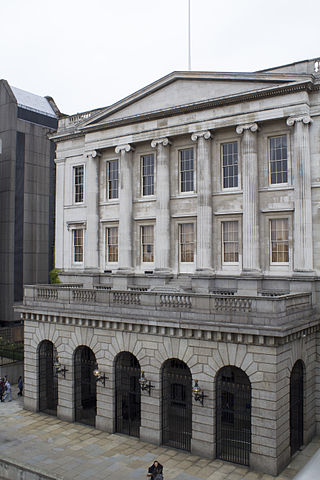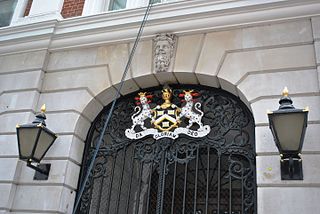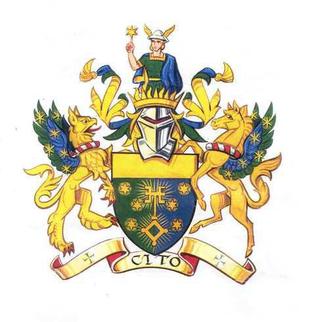
A livery company is a type of guild or professional association that originated in medieval times in London, England. Livery companies comprise London's ancient and modern trade associations and guilds, almost all of which are styled the "Worshipful Company of" their respective craft, trade or profession. There are 111 livery companies in total. They play a significant part in the life of the City of London, not least by providing charitable-giving and networking opportunities. Liverymen retain voting rights for the senior civic offices, such as the Lord Mayor, Sheriffs and Common Council of the City Corporation, London's ancient municipal authority with extensive local government powers.

The Worshipful Society of Apothecaries of London is one of the livery companies of the City of London. It is one of the largest livery companies and ranks 58th in their order of precedence.

The Worshipful Company of Goldsmiths, is one of the Great Twelve Livery Companies of the City of London, headquartered at Goldsmiths' Hall, London EC2.

The Worshipful Company of Dyers is one of the Livery Companies of the City of London. The Dyers' Guild existed in the twelfth century; it received a Royal Charter in 1471. It originated as a trade association for members of the dyeing industry but is now mainly a charitable institution. Each year the company participates in the ceremony of Swan Upping along the River Thames.

The Worshipful Company of Ironmongers is one of the Great Twelve livery companies of the City of London, incorporated under a Royal Charter in 1463.

The Worshipful Company of Clothworkers was incorporated by Royal Charter in 1528, formed by the amalgamation of its two predecessor companies, the Fullers and the Shearmen. It succeeded to the position of the Shearmen's Company and thus ranks twelfth in the order of precedence of Livery Companies of the City of London.

The Worshipful Company of Cutlers is one of the ancient Livery Companies of the City of London. It ranks 18th in the order of precedence of the Companies.

The Worshipful Company of Pewterers is one of the 111 Livery Companies of the City of London. It ranks 16th in the order of precedence of City Livery Companies and has existed since at least 1348. Like all the other City Livery Companies, the Worshipful Company of Pewterers has four main pillars of activity: Charitable endeavour, assistance to education, support for its trade and profession, and being a convivial and caring social community.

The Worshipful Company of Brewers is one of the ancient livery companies of the City of London.

The Worshipful Company of Armourers and Brasiers is one of the livery companies of the City of London. The Armourers' Guild was established in 1322; it received a royal charter in 1453. Other companies, including the Armour Repairers, merged with the Armourers. In 1708, brass workers joined the company, which was renamed as the Armourers' and Brasiers' Company. The company does support the metallurgy industry, but does not retain a close association with its original trade, as is the case with a majority of livery companies. It exists primarily as a charitable establishment.

The Worshipful Company of Cordwainers is one of the Livery Companies of the City of London. Cordwainers were workers in fine leather; the Company gets its name from "cordwain" (cordovan), the white leather produced from goatskin in Cordova, Spain. All fine leather makers, including Girdlers and Glovers, were originally classified as cordwainers; however, the term eventually came to refer only to fine leather footwear, including boots.

The Worshipful Company of Carpenters is a livery company of the City of London. The Carpenters were traditionally different from a fellow wood-crafting company, the Worshipful Company of Joiners and Ceilers, in that carpenters utilised nails while joiners used adhesives to attach wood.
The Worshipful Company of Broderers is one of the livery companies of the City of London. Broderers were workers in embroidery; the organization of Broderers existed in at least 1376, and was officially incorporated by a royal charter in 1561. As the craft of embroidery has lost its importance as a trade, the company has become less of a trade association for broderers. Instead, the company is now, as are most livery companies, a charitable foundation.
The Worshipful Company of Fan Makers is one of the Livery Companies of the City of London. The company was incorporated by a Royal Charter in 1709. As fan making is now done by machines rather than by craftsmen, the company is no longer a trade association for fan makers. Instead, the Company functions as a charitable establishment.

The Worshipful Company of Insurers is one of the 111 livery companies of the City of London. It ranks 92nd in the City Livery Companies' order of precedence. Its motto is Omnium Defensor, Latin for Protector of All and its church is St Lawrence Jewry.

The Worshipful Company of Information Technologists, also known as the Information Technologists' Company, is one of the livery companies of the City of London. The company was granted livery status by the Court of Aldermen on 7 January 1992, becoming the 100th livery company. It received its Royal Charter on 17 June 2010 from Prince Edward.

The Worshipful Company of Firefighters is one of the 111 livery companies of the City of London. The Company's aim is to promote the development and advancement of the science, art and the practice of firefighting, fire prevention and life safety. It operates essentially as a charitable organisation, and also encourages professionalism and the exchange of information between members and others who work in allied fields.

Goldsmiths' Hall is a Grade I listed building at the junction of Foster Lane and Gresham Street in the City of London. It has served as an assay office and the headquarters of London's goldsmith guild, the Worshipful Company of Goldsmiths, one of the livery companies of the City of London. The company has been based at this location since 1339, the present building being their third hall on the site.
William Lee (1563–1614) was an English clergyman and inventor who devised the first stocking frame knitting machine in 1589, the only one in use for centuries. Its principle of operation remains in use.
The Broderers' Hall or Embroiderers' Hall at 36 Gutter Lane was the livery hall of the Worshipful Company of Broderers, the City of London livery company for embroiderers from 1515 until its destruction in 1940.
















